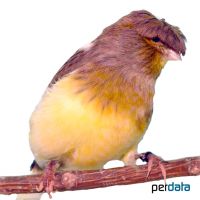Domestic Canary-Gloster Corona ♂ (Serinus canaria f. dom.)
| Domestic Canary-Gloster Corona ♂ Serinus canaria f. dom. | |
|---|---|
| Name | Domestic Canary-Gloster Corona ♂ |
| Name Lat. | Serinus canaria f. dom. |
| Family | Finches and Allies |
| Family lat. | Fringillidae |
| Order | Perching Birds |
| Order lat. | Passeriformes |
| Origin | Breed |
| Climate | Temperate |
| Diet | Canary seed, veggies, fruits, insects |
| Keeping | Pair, group |
| Care Level | Easy |
| Reproduction | Cup nest |
| Life Span | 6-10 years |
| Protection | No |
| Metric Units | |
| Size | 11 cm |
| Temperature | Room temperature |
| Housing | 80 x 40 x 40 cm |
| US Units | |
| Size | 4.3" |
| Temperature | Room temperature |
| Housing | 30" x 15" x 15" |
Distribution and habitat
The canary is the domesticated form of the Canary (Serinus canaria), native to the Canary Islands, Azores and Madeira, where it lives in the forest and scrubland. The canary is bred in many color mutations and posture breeds.
Cage size
The minimum cage size is 120 x 60 x 80 cm (L x W x H) for 2-4 animals. The cage must be placed in a bright, draught-free and quiet place at a height of at least 80 cm (except aviaries), have a rectangular base and be opaque on three sides, aviaries on one side. Keeping in an indoor aviary (e.g. 200 x 100 x 200 cm) is preferable. Birds kept in a cage should be allowed daily controlled free flight indoors without danger after a period of acclimatization.
Maintenance
The floor must be covered with sand, wood granulate, bark mulch or similar material and must be cleaned regularly. At least 3 perches made of wood or branches of varying thickness and height must be installed in such a way that they can only be reached by flying and that the longest possible flight distance is created. They need a bathing opportunity as well as biotope-like hiding, sleeping and nesting possibilities. It is recommended to provide them with grasses and bushes. They should be kept at room temperature, between 18 and 25 °C.
Diet
The species-specific food offer consists of mixed seeds, available in specialized trade as "canary food" in premium quality, supplemented with foxtail millet, vitamin crackers, green food (chickweed, green panicle millet, cucumber slices, organic lettuce, dandelion, etc.), fruit (apples, knaw grass seeds, insect food and especially germinated seeds (niger seeds, turnips, some mung beans).), fruit (apples), tangle grass seeds, insect food and especially for raising young germinated seeds (niger seed, turnip, some mung beans) and hard-boiled chicken egg mixed (crumbly) with canary egg food. Charcoal, vitamin lime and shell grit are needed as digestive aids. Drinking water must always be available in birdbaths or in stable, open containers and, like food, must be offered fresh daily in clean containers.
A regular and varied diet promotes health and prevents deficiency symptoms.
Reproduction and breeding
The sexes can be distinguished by the song of the males and in the breeding phase by the cone (thrust) of the sexual part of the cock, and in the females by the pear-shaped abdomen (cloaca).
They breed in open nesting baskets or so-called emperor nests, which are attached to the outside of the cage. Coconut felt nest liners are recommended to secure the nest construction. As nesting material is suitable nest wool (Scharpie), jute fibers and possibly some fresh moss. The clutch consists of 4-6 eggs, the incubation period is about 13 days. The breeding season is, biologically speaking, all year round. Do not allow more than 2-3 broods per year! When breeding, the room temperature should be at least 15 °C.
Important
Canaries may be kept only in pairs or in a group. An aviary is required for keeping a group. They must not be kept in a round cage.
When kept in an outdoor aviary with a height of at least 1.70 m, they also require a heated shelter with a floor area of at least 1 m², which can be visited by the birds at any time. The temperature in the shelter must not fall below 10 °C and the furnishings must be the same as those used for caging
Sufficient daylight or flicker-free artificial light (stroboscopic effect) corresponding to daylight must be provided in rooms, including the shelters. The lighting duration shall be 8-14 hours per day and the natural day-night rhythm shall be respected. Adequate indoor climate shall be provided. The health condition of the birds shall be checked daily
Further literature can be found in your pet store.
References
Text: Othmar Sieberer; Image: petdata
Source: BMEL (1995): Tierschutzgutachten - Mindestanforderungen an die Haltung von Kleinvögeln; BMEL-Haustier-Berater.de; CLASSEN (2001): Kanarien, Ulmer Verlag; GRUMMT & STREHLOW (2009): Zootierhaltung - Tiere in menschlicher Obhut: Vögel, Verlag Harri Deutsch
- Gemäß § 21 Abs. 5 Tierschutzgesetz idgF
